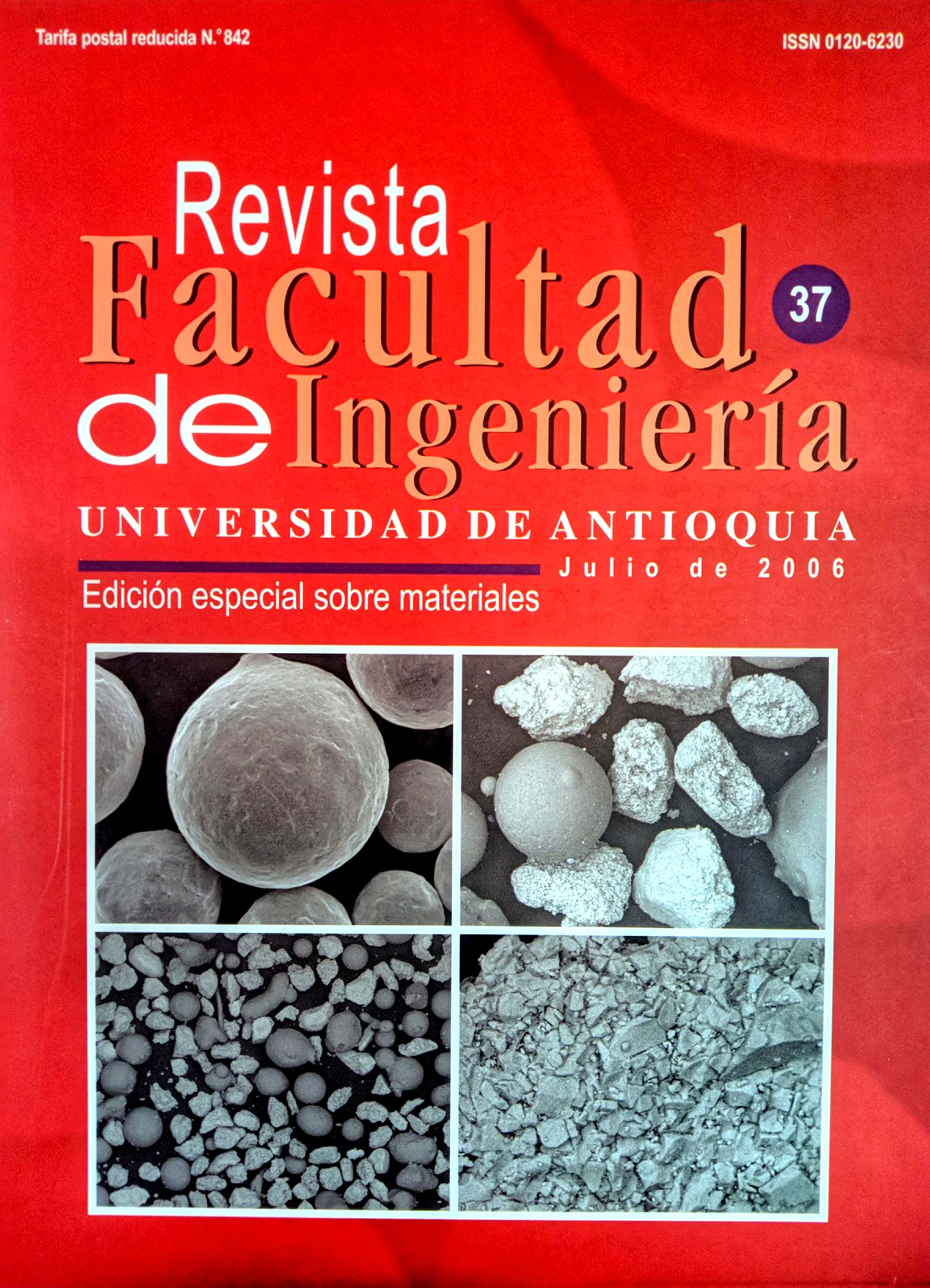Efecto del catalizador LeachWell 60X® y de los iones Pb+2 y S-2 en el proceso electroquímico de la cianuración del oro en minerales sulfurados
DOI:
https://doi.org/10.17533/udea.redin.343416Palabras clave:
catalizadores, cianuración intensiva, oro, sulfuro, LeachWell 60X®Resumen
La gran dificultad que se presenta en la disolución del oro por cianuración, cuando se encuentra en minerales sulfurados, es un hecho ampliamente conocido en la metalurgia extractiva. En este trabajo se evaluó la interferencia del ión sulfuro (S-2), así como el efecto del catalizador LeachWell 60X® (LW) y del ión Pb+2 en el comportamiento electroquímico del proceso de disolución de oro con cianuro. Se emplearon métodos potenciodinámicos de barrido lineal y cíclico para estudiar la oxidación anódica del oro y la reducción catódica del O2 bajo condiciones de cianuración convencional (1.000 p. p. m. de CN- y O2 ambiental 5,2 p. p. m.) y de cianuración intensiva (25.000 p. p. m. de CN- y saturado de O2 24 p. p. m.). Los resultados indican que el Pb+2 y el LW se comportan de manera similar y que incluso bajas concentraciones de S-2 (entre 0,5 y 10 p. p. m.) tienen un efecto negativo en la disolución anódica del oro. La velocidad de disolución del metal precioso se predijo aplicando la teoría del potencial de mezcla. El incremento significativo en la velocidad total de la reacción se atribuye principalmente al aumento en la velocidad de reducción del O 2
Descargas
Citas
N. Grigg, S. Dorey. “Preliminary investigation into gravity concentration, intensive cyanidation and electrowinning of Nezhdaninskoye. Rom Ore”. Gekko Systems, Australia, 2002. http://www.celticresources.com/archive/Gekko%20Test%20ReportFeb%202002.pdf. Consultado el 20 de enero de 2005.
D. Kirk, W. Foulkes, F. R. Graydon. “A study of anodic dissolution of gold in aqueous alkaline cyanide. J. Electrochem. Soc. Vol. 125. 1978. pp. 1436-1443. DOI: https://doi.org/10.1149/1.2131692
X. Sun, C. Guan, K. Han. “Electrochemical behavior of the dissolution of gold-silver alloys in cyanide solutions”. Metallurgical and Materials Transactions B. Vol. 27B. 1996. pp. 355-367. DOI: https://doi.org/10.1007/BF02914898
M. Jeffrey, P. Breuer. “The cyanide leaching of gold in solutions containing sulfide”. Minerals Engineering. Vol. 13. 2000. pp. 1097-1106. DOI: https://doi.org/10.1016/S0892-6875(00)00093-5
O. May, S. Jin, E. Ghalie, G. Deschenes. “Effects of sulfide and lead nitrate addition to a gold cyanidation circuit using potentiodynamic measurements”. Journal of Applied Electrochemistry. Vol. 35. 2005. pp. 131-137. DOI: https://doi.org/10.1007/s10800-004-4064-z
M. Aghamirian, W. Yen. “Mechanisms of galvanic interactions between gold and sulfide minerals in cyanide solution”. En: Minerals Engineering, Vol. 18. 2005. pp. 393-407. DOI: https://doi.org/10.1016/j.mineng.2004.07.005
K. Cerovic, H. Hutchison, R. Sandenbergh. “Kinetics of gold and a gold–10% silver alloy dissolution in aqueous cyanide in the presence of lead”. Minerals Engineering. Vol. 18. 2005. pp. 585-590. DOI: https://doi.org/10.1016/j.mineng.2004.09.010
M. Aghamirian, W. Yen. “A study of gold anodic behavior in the presence of various ions and sulfide minerals in cyanide solution”. Minerals Engineering. Vol. 18. 2005. pp. 89-102. DOI: https://doi.org/10.1016/j.mineng.2004.05.008
M. Van Brussel, G. Kokkinidis, A. Hubin and C. BuessHerman. “Oxygen reduction at platinum modified gold electrodes”. Electrochimica Acta. Vol. 48. 2003. pp. 3909-3919. DOI: https://doi.org/10.1016/S0013-4686(03)00529-2
Y. Guan, K. Han. “An electrochemical study on the dissolution of gold and copper from gold-copper alloys”. Metallurgical and Materials Transactions B. Vol. 25B.1994. pp. 817-825. DOI: https://doi.org/10.1007/BF02662764
A. Kongkanand, S. Kuwabata. “Oxygen reduction at silver monolayer islands deposited on gold substrate”. Electrochemistry Communications. Vol. 5. 2003. pp. 133-137. DOI: https://doi.org/10.1016/S1388-2481(03)00007-9
Descargas
Publicado
Cómo citar
Número
Sección
Licencia
Derechos de autor 2006 Revista Facultad de Ingeniería Universidad de Antioquia

Esta obra está bajo una licencia internacional Creative Commons Atribución-NoComercial-CompartirIgual 4.0.
Los artículos disponibles en la Revista Facultad de Ingeniería, Universidad de Antioquia están bajo la licencia Creative Commons Attribution BY-NC-SA 4.0.
Eres libre de:
Compartir — copiar y redistribuir el material en cualquier medio o formato
Adaptar : remezclar, transformar y construir sobre el material.
Bajo los siguientes términos:
Reconocimiento : debe otorgar el crédito correspondiente , proporcionar un enlace a la licencia e indicar si se realizaron cambios . Puede hacerlo de cualquier manera razonable, pero no de ninguna manera que sugiera que el licenciante lo respalda a usted o su uso.
No comercial : no puede utilizar el material con fines comerciales .
Compartir igual : si remezcla, transforma o construye a partir del material, debe distribuir sus contribuciones bajo la misma licencia que el original.
El material publicado por la revista puede ser distribuido, copiado y exhibido por terceros si se dan los respectivos créditos a la revista, sin ningún costo. No se puede obtener ningún beneficio comercial y las obras derivadas tienen que estar bajo los mismos términos de licencia que el trabajo original.










 Twitter
Twitter